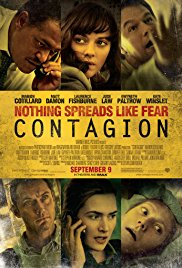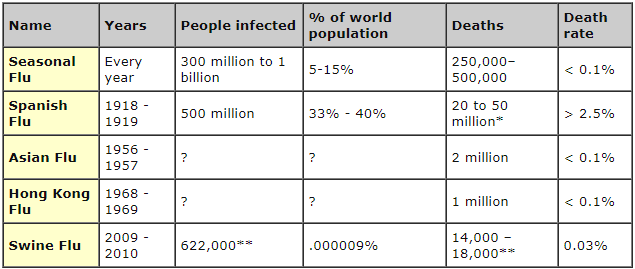* Some estimates are that as many as 100 million people died of the Spanish Flu.
** These are from verified lab results and probably are substantially under-reported.
The actual numbers are thought to be much higher.
While the Spanish Flu was the worst flu pandemic in modern history, in some ways the world was lucky. While it was 20 times more lethal than ordinary seasonal flu, the Spanish Flu was not as infectious as other illness such as the common cold, smallpox or measles. Still, more people died from the Spanish Flu pandemic than from the hostilities in World War I. It is estimated that half of the U.S. soldiers who died in Europe were killed by the influenza virus, and a total of 675,000 people died from the pandemic in the U.S. (550,000 of these were excess deaths, that is deaths that would not have happened but for the flu.) The life expectancy in the U.S. was cut by 11.8 years due to the Spanish Flu.
Influenza epidemics can exhibit different infection patterns from the seasonal flu which kills the elderly, the chronically ill, and very young children. The Spanish Flu was most deadly for people ages 20 to 40. It struck down the strong and vigorous. people sometimes died rapid deaths, sometimes within hours of the onset of symptoms. Entire families were wiped out; in other families, just one or two people survived. Children lost their parents, parents lost their children, husbands their wives, etc. The emotional toll on the survivors was devastating. The deaths were painful. One physician described his patients as dying while “struggling to clear their airways of a blood-tinged froth that sometimes gushed from their nose and mouth.” Diary of Isaac Starr, a third-year medical student recruited to treat victims
Outbreaks swept the globe. In India, the mortality rate was 50 deaths per 1,000 people. Doctors of the time were powerless against the disease. The influenza virus was not even identified until 1933.
Public health officials of the affected areas were unable to stop the spread of the disease. They tried everything they could think of from distributing gauze masks to prohibiting stores from holding sales, limiting funerals to 15 minutes, banning meetings, restricting entry into the town, to name a few. Nothing worked. There was also a lack of health care workers due to illness or death. There was also a shortage of coffins and bodies piled up in morgues and funeral homes.
Scientists now think that most of the deaths from the 1918/1919 flu pandemic were the result of secondary bacterial pneumonia. Bacteria from the nose and throat were able to infect the lungs because the virus damaged the bronchial tubes and the lining of the lungs. With the development of antibiotics that can treat pneumonia, later pandemics have caused many fewer fatalities
Lasting a little over a year and killing between 20 million and 50 million people, the Spanish Flu was one of the worst pandemics in history. It compares to the Plague of Justinian, 541 – 590 A.D., in which 25 – 100 million lost their lives over 50 years, the Black Death of 1348-1351 in which 62 million lives were lost in about three years, and the current AIDS epidemic in which 34 million have died over 20 years. All of these numbers are approximate.
The 1918/1919 outbreak was dubbed the “Spanish Flu” because reporters in Spain, a country which was not a combatant in WWI, were not focused on reporting the war and were the first to realize that a new and dreadful disease was killing people. The strain of influenza responsible for the pandemic didn’t originate in Spain nor was it any worse there than in other places.
Scientists have recently been able to reconstruct the Spanish Flu virus from samples preserved in wax and tissues from people who were frozen in the Alaskan permafrost and recently unearthed. It appears to have bird genes which means that it jumped from birds to humans.
There are, on the average, three influenza pandemics every century. Dr. Robert Webster, a renowned virologist has stated that “All the genes of all influenza viruses in the world are being maintained in aquatic birds, and periodically they transmit to other species. . . . The 1918 viruses are still being maintained in the bird reservoir. So even though these viruses are very ancient, they still have the capacity to evolve, to acquire new genes, new hosts. The potential is still there for the catastrophe of 1918 to happen again.” The 1918 Spanish Flu Pandemic, and the Emerging Swine Flu Pandemic from NinthDay.com; accessed February 12, 2012.
THE POWER OF THE STATE TO QUARANTINE PEOPLE AND COMMUNITIES WITH INFECTIOUS DISEASES
When the people, acting through their government, enact laws or take action to protect the peace, security, safety, morals, health, and well-being of the community, they are said to be acting pursuant to the “police power.” This power is broad and flexible. It has no clear limits, permitting the state to act as necessary to protect the public welfare. Other examples of police power include zoning ordinances, building codes, the regulation of sanitation in dwellings and businesses, traffic laws, as well as safety regulations in the workplace. The power of the government to quarantine persons with contagious disease derives from the police power of the state.
In the United States, the police power is limited by those rights reserved to individuals by the Bill of Rights (as to the Federal Government), the Fourteenth Amendment to the Constitution (which requires the states to recognize most of the provisions of the Bill of Rights), and various state constitutional provisions which on occasion grant more rights than the U.S. Constitution. The Fifth Amendment and the Fourteenth Amendment specifically prohibit the Federal Government and the states from taking life, liberty or property from individuals without due process of law. This means that the government cannot punish, imprison or kill anyone unless that person has been convicted of a crime. The police power often comes into conflict with these individual rights. The courts in the United States are constantly required to decide disputes about which will prevail in specific situations: the power of the state to provide for the general welfare or the rights of individuals reserved to them by various constitutional provisions. (Another film which raises the conflict between the power of the people as a whole and the rights of individuals is Inherit the Wind. In that case, the conflict was between the power of the people to regulate what was taught in the public schools and freedom of speech, guaranteed by the First Amendment.)
Quarantine deprives people of their liberty not because they have committed any crime, but due to their exposure to a dangerous communicable disease. The power of the state to impose quarantines has been recognized for many hundreds of years.
There have been situations in the past when constitutional rights have been suspended or ignored as a matter of policy by the government. Usually, these occur in the time of war. During the Civil War, President Lincoln suspended the right of habeas corpus. (The right of habeas corpus is exercised when a person who has been imprisoned by the government petitions a court to review the correctness of the government’s action.) Another example was the detention of Japanese Americans during World War II.




